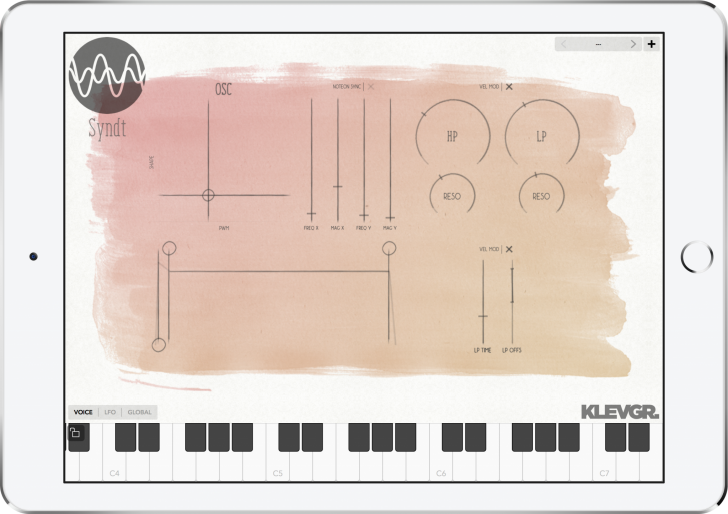Klevgränd has introduced Syndt for Mac, Windows & iOS – the most advanced synth in their Kanvas series of synths.
The oscillator waveform can be morphed between pure sine to pure square, and supports altering of pulse width. Both the shape and pulse width can be modulated by two independent LFOs. It also offers fine-tuned low pass and high pass filters combined with a separate filter attack setting, (optionally based on velocity).
The additional LFO can be shaped exactly as the oscillator, and optionally controls filters, gain and pitch (using a modulation wheel or just automatically). This LFO can be synchronized to a AUv3 host.
Video Demo:
Features:
- 70+ professionally made presets
- XY pad based oscillator and LFO (PWM on the X axis and morphs between sine and square on the Y axis)
- Independent mini-LFO (sine only) for each axis of the oscillator XY-pad.
- LP / HP filter with resonance
- LP Filter can be velocity sensitive
- LP Filter has an optional attack time
- LFO can affect LP filter, HP filter, gain level and pitch
- LFO has an optional attack time
- LFO can be synchronized with an AUv3 host (AUv3 mode only!)
- Ping pong delay
- Stereo Chorus
- Three-band EQ
- Legato mode with glide speed parameter
- Pitch bend range
iOS version
- AUv3, works with AUv3 compatible hosts like GarageBand, Cubasis, Auria, AUM etc.
- Delay can be synchronized with an AUv3 host (AUv3 mode only!)
Desktop version
- Audio Units version, compatible with most Mac OS X DAW’s
- VST version, compatible with most Mac & Windows DAW’s
- System requirements: Mac OS X 10.7+ / Windows 7+ with SP1 or higher
Audio Demos:
Pricing and Availability
Syndt is available for iPad (AUv3) in the App Store and for desktop as a AudioUnit and VST at the Klevgränd site. It currently has an intro price (~35% off for iOS and 20% off for desktop) – Syndt for iOS costs $4.99 and Syndt for desktop costs $19.99.


“70+ professionally made presets” – I prefer unprofessionally made presets.
Good point. I always go for synths with amateur created presets.
The demo track sounds nice. Seems like with the basic square & pulse you can get some chiptune kinds of things. That minimalist GUI is something I’d have to get used to . I don’t mind that kind of thing, but at a glance I just think, “It won’t do what I need it to do, it’ll just do what it does.”
I don’t really understand all the love hysteria about these minimalist synths…. Just because i don’t understand doesn’t mean I’m right though. They seem to be well respected. Why are they?
I bought one of them (forget the name) and it consisted of a few very flat and boring presets. I think it was a pad synth? I got refund on it. I bought jussi (?) and have kept that.
So what’s the appeal of these minimalist synths?
Why are desktop versions of synths/samplers/drum machines/etc. considerably more expensive than iOS versions? Are they more expensive to license? More to develop? More features on the desktop version? This is an honest question. I’m thinking of this one, and also of the Korg Gadget, which is (at full price) $40 for iOS and $300 for VST.
This is a good question. However I think Korg didn’t do a good job of promotion or naming of the desktop version of Gadget, because this is one example in which the price is comparable to the iOS version as the desktop version includes all the synths that work in Gadget that are separate purchases in iOS, plus all IAPs for those apps and for Gadget too, except for one. If you do the math they are much nearer in price than most all other software examples.
Can’t answer your question but know the Gadget for iOS is considerably more than $40 if you get all of the IAPs that the desktop version comes with. Not $300 but in the $150 range.
no midi.